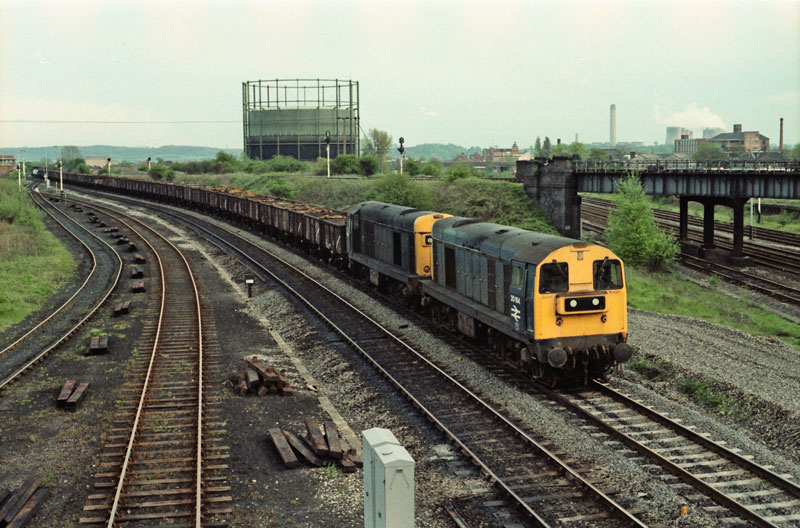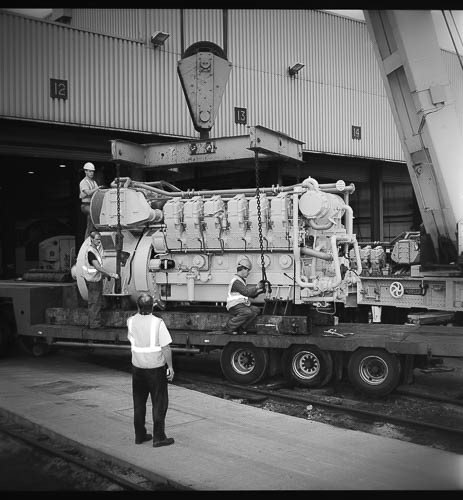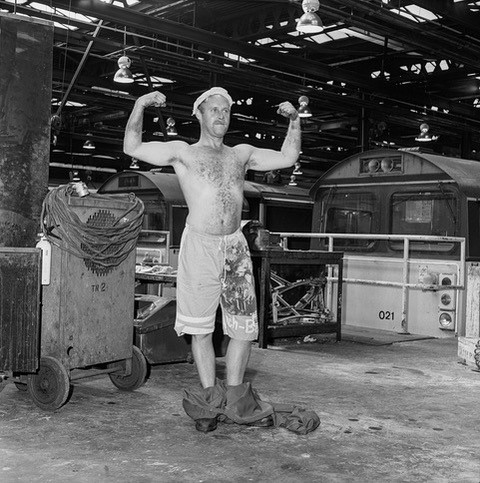Steam Locomotives |
The Midland Railway was famous fot its small engine policy, working on the principle that you could always put two engines on a big train. The long and heavy coal trains from Toton to London would be double-headed. Even after the Midland Railway became part of the London, Midland & Scottish Railway in 1923, there was still a shortage of big powerful freight locomotives.
Eventually a big engine was commissioned specially for the Toton-London Brent Yard coal trains. It was developed by the MR locomotive chief Henry Fowler and builders Beyer Peacock. The Beyer Garratt 2-6-0 + 0-6-2 articulated locomotive was the result, introduced from 1927.
With one exception, these were the only Garratts to run on British main line railways. (from David Copeland) |
.jpg) |
| They were very powerful and could handle a 1,400 ton load with only the locomotive and guard's van to provide braking power. |
.jpg) |
.jpg) |
| They were, of course, very heavy on coal and the poor Toton based firemen needed gallons of tea as they sweated their way down to Wellingborough! There are still men living around Long Eaton who remember these demanding shifts. |
Facing the camera in this shot of 47972 is the large water tank with a capacity of 3030 gallons. The second water tank located at the other end carried 1470 gallons. Thus a top up could involve two separate fillings! |
.jpg) |
.jpg) |
| Here 47971 is seen at Trent South Junction taking the goods avoiding line which would take it over the high level bridge with its load of empty wagons. The Garratts were strictly forbidden on the hump as the engine would get stuck at the summit! |
Sunday line-up of Garratts at Toton Shed. These engines were too large to enter the depot and were accomodated on outside lines adjacent to the shed. They needed a good deal of maintenance suffering particularly from hot axle boxes. |
.jpg) |
.jpg) |
| The 33 Garratts were built to teplace 68 old freight locos which often had to work in tandem. Each Garratt covered around 600,000 miles and they lasted 30 years. Over half were housed and maintained at Toton Shed. They were all scrapped by 1958 and none were preserved. |
The loco was 87 ft long and weighed 155 tons. It looks like a way of getting two men to do the work of 3! Would the later railway unions have allowed it?!
To view a larger and clearer image of this Garratt drawing click here |
.jpg) |
.jpg) |
| To work with the Garratts, the LMS built a heavy 2-8-0 freight locomotive, the 8F, of which several are lined up here at Toton by the coaling plant. It was the design of William Stanier, who came to the LMS from Swindon in 1932, |
Here an 8F trundles through Stapleford & Sandiacre Station on its way north with a long train of empties. These engines were well liked by crews with their reliability and generally good steaming |
.jpg) |
.jpg) |
| Toton sheds were built on the Roundhouse pattern with one road in and then the turntable as shown here. The turntable was turned to point to the required stabling road. |
The 8F was also well liked by the maintenance staff and you can see the high running plate gives good access to the loco motion. They continued working right up to the demise of steam in the 60s. |
.jpg) |
.jpg) |
| Of course the homely 0-8-0 diesel shunters so vital to the day-to-day shunting of the yards were also maintained and fuelled at Toton. They generally had enough fuel to last all week. |
This splended picture taken by the late Brian Amos shows the last of the heavy freight designs on the railway. It is a 2-10-0 loco designed by Riddles of British Railways. Toton had several and their appearance spelt the demise of the hard-working Garratts. |
Toton Diesel Maintenance Depot
Competition from road haulage and other factors impelled railway managers to make freight handling more efficient. As a result both the loose coupled wagon and the steam locomotive were considered a hindrance to progress. More and more block train workings, particularly on the mineral merry-go-round trains between collieries and power station, hastened the decline of Toton. By 1984 both humps had gone and Toton had a thriving diesel depot which had already earned a reputation for its expertise maintaining the new diesel locos. Not all steam drivers were happy to make the transition, in some cases taking early retirement, but many applauded the vast improvement in comfort and reliability. |
.jpg) |
.jpg) |
| A Merry-Go Round mineral train entering Radcliffe Power Station. These trains spelt the end of Toton Sidings as a major yard. |
A diesel loco D68 alongside a long serving diesel shunter outside the new Toton diesel depot. |
.jpg) |
.jpg) |
| Among the first diesels to arrive at Toton were the Brush Type 4s (later Class 47) but Toton will always be remembered for the Class 44 'Peaks'. All ten were shedded at Toton after spending the first two years of the 60s on the West Coast Main Line. |
If a Peak went out at times when power was short, managers could rely on their quick return as no other depot had the staff who could drive them! While 44003 was withdrawn in July 1976, the class lasted at Toton till 1980. |
 |
| The other diesel traaction especially associated with Toton were the Class 20s English Electric Freight Locos. They usually worked in pairs unless in charge of local trips eg to Stanton Ironworks. |
Some Class 20s were fitted with slow speed control so that they could work the colliery merry-go-round trains. The class lasted into the 1990s. |
.jpg) |
.jpg) |
| In 1976, a new locomotive appeared - the class 56. The first 30 were made in Romania in a hurry becuase of expected surge in coal traffic after the oil price rise of that time. |
The Class 56 were fitted with sanding gear and were more powerful than the 47s they replaced. They were specifically designed for freight haulage and were given better traction capability. |
Working in the Depot in the 90s
These wonderfully evocative B/W pictures of the Toton Diesel Maintenance Depot were taken in 1993/4 by an amateur photographer called Mick Rhodes. Mick worked at Toton as a fitter having served his apprenticeship at Arnold and SE Derbyshire Colleges in 1979.
Mick was encouraged in this photographic project by a graduate engineer working there at the time. The Toton Sidings Remembered project team was delighted to receive these pictures and has covered the cost of printing from negatives for the exhibition. |
| If you would like to purchase prints, please contact Mick Rhodes by email or through instagram on @lofty228. A 10 x 8 hand printed photo to high quality would cost £10 + pp. |
.jpg) |
.jpg) |
| A class 58 engine has been removed from its loco ready for shipping out for re-conditioning. The photo was taken around 1995 not long before BR was wound down/split up for privitisation in 1996. |
A re-conditioned engine from Doncaster is hoisted from a low loader by a 76 ton breakdown crane ( a crane was later installed inside the depot). Such work (Level 5) was not done at Toton at that time. |
 |
.jpg) |
| In 1995, the depot was still Level 4 but around this time Toton started doing some level 5 work such as power unit changes. |
The Class 58 gets its reconditioned engine. The task would have taken 2-3 days. |
.jpg) |
.jpg) |
| Roads 5 to 12 with a line-up of Class 56 and Class 58 locos awaiting attention .. an impressive site indeed. Mick took this from an overhead crane ladder. |
In the lifting bay, a Class 56 is off its bogies for traction motor and bogie maintenance. Note the 20 ton Matterson Screw Jacks and the 2 new compressor motors in the foreground. |
.jpg) |
.jpg) |
| This shows a brilliant solution to moving bogies in pairs at the lifting bay and a purposely designed bar and bracket for loco attachment. It gives an idea of the level of skill and ingenuity people had at this depot. |
A Class 56 is undergoing an F examination. Note the removed roof panel is stored above the engine to save space on the depot floor. Another useful home-grown idea! |
.jpg) |
.jpg) |
| Part of the wheel set of a Class 08 diesel shunter removed for attention on the lifting bay. These shunters did all the hump shunting at Toton. |
A fitter at work in the engine room of a Class 56 diesel. They had to work in cramped conditions often with heavy components to manipulate. |
.jpg) |
.jpg) |
| Two class 56 locos share the lifting bay (13-15 roads) with an overhead crane, later replaced by a gantry. Most of the guys who worked in this section did so because they preferred it |
During the F exam of a Class 56, a piston liner is winched out for replacement.The class had a 16 cylinder engine developing 5,000 hp! |
.jpg) |
.jpg) |
| one of the inspection pits in use . This was, of course, a marked improvement in working conditions campared to the sooty, ash-strewn pits of steam loco days |
The works canteen at Toton. Barbara James tells a good story of working here as a young teenager and the shock of lifting the counter screen on day 1 to reveal all these men waiting to be fed! |
 |
.jpg) |
| One of the characters of Toton in the 90s, Pothole Pete(?). Mick writes "Like most heavy industry in the country, there was great canaradery and although there were many disagreements and flare-ups, there was a lovely sense of a 'railway family'. |
Some real characters here at the stores hatch. Toton held a very large stock of spare parts. The efficient administration at Toton Depot helped to quickly establish it as one of the leading maintenance centres in the UK. |
.jpg) |
.jpg) |
Although the depot was large it could still get pretty full inside. Occasionally maintenance staff would work on the locos outside and this 58 loco has a ‘not to be moved’ stop board fitted with an identification tag on the stop board. This is part of the depot safety system. |
A sad sight. The damage here shows how badly wrong things can go when such heavy trains are in motion. |
.jpg) |
.jpg) |
| Toton held a comprehensive collection of spares in its stores. This well organised facility was vital for the quick turnaround of locos brought in. |
A sad picture for those who worked here in the 50s and 60s is the remains of one of the two control towers used in the massive hump shunting operation of steam days. |
.jpg) |
.jpg) |
| Here bogies have been removed from loco 56017, possibly to use for parts. It looks like the loco is due to be scrapped for some reason. |
Another view of the busy depot with a line of engines in for maintenance. |
| back to top
|
.jpg)
.jpg)
.jpg)
.jpg)
.jpg)
.jpg)
.jpg)
.jpg)
.jpg)
.jpg)
.jpg)
.jpg)
.jpg)
.jpg)
.jpg)
.jpg)
.jpg)
.jpg)

.jpg)
.jpg)
.jpg)
.jpg)

.jpg)
.jpg)
.jpg)
.jpg)
.jpg)
.jpg)
.jpg)
.jpg)
.jpg)
.jpg)
.jpg)

.jpg)
.jpg)
.jpg)
.jpg)
.jpg)
.jpg)
.jpg)